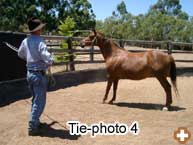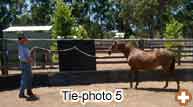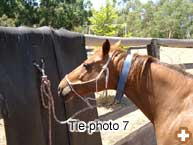----------------
Visit Often?
Site constantly updated...
or hit
CTRL + F5
----------------
|
|
|
 On
Tying Your Horse On
Tying Your Horse
- If the object of tying a horse is to prevent it from wandering off,
why tie it to or with something that is easily broken? How often do
you see a horse tied to a piece of twine? If you ask the owner of
that horse, "Why?", they will most likely tell you that
the horse pulls back and they don't want it to break the halter, leadrope,
bridle or whatever. Every time the horse succeeds in breaking that
twine it is a reinforcement to him that he can break away
whenever he feels like it.
If you have a horse that pulls back, what do you do about it?
- (BE AWARE THIS IS FOR THE CONFIRMED PULLER and NOT FOR THE YOUNG
UNEDUCATED HORSE! We'll deal with the youngster shortly)
If a horse has the habit of pulling back and has been doing it successfully
for some time it can take a long, long time to get him over that habit.
In fact some horses will never truly get over it. But for that matter,
any horse will pull back to escape if the stimulus is great enough.
Survival is the strongest 'habit' of them all.
The first thing you can do is never again tie him to or with
something that he can break. Most halters will fail at the
ring where the lead connects. Most lead ropes have flimsy snap hooks
that break easily. Get a good quality knotted rope halter and a strong
lead rope with a stout bullsnap as in Photos 1 & 7.
Tie your horse to something that will not break and make sure
that he cannot hurt himself if he should pull back and struggle.
The broad neck strap in Photo 7 is a preferred option
if the horse is a violent puller or in teaching the very young.
Avoid tying him to a fence. Not only may the fence not be strong
enough but the horse can get his legs between/under the rails or the
wire and hurt himself.
Avoid tying him to the side of the float. He can easily cut himself
on the sharp edges there….to say nothing about the damage a struggling
horse can do to your float.
Avoid tying him next to or within reach of other horses. If your
horse pulls back there is good chance it will set the other horses
off and cause a wreck.
Tie your horse to a solid point with no protrusions or places where
a leg can get hung up. The tie point should be no lower than his wither
and leave just enough slack so that the horse can move his head about
comfortably but not enough to allow him to get his head below his
chest. Any more slack than that and you risk the horse getting a leg
over the rope.(Photos 1 & 7) Tying your horse with
enough slack to allow him to eat may seem kind but you could be setting
him up for a real wreck. (Photos 8 & 9)
- If you follow the above and never allow him to break away, he may,
over time get to where he can safely be tied.
How do you teach a young horse to stand quietly while tied and
not pull back?
What you do not do is immediately tie the horse up and start
waving bags at him. All that will accomplish is confirm to the horse
that tied up is not the place to be and he will almost certainly fight.
"Good!", you say, "I want him to fight so that he learns
that fighting is useless." WRONG!! You are merely starting
the mindset in the horse that tying equates to being frightened
and fighting.
First, teach the horse to respond to pressure on the lead rope. In
other words:
- 1. get him to where he is leading softly and without
hesitation.
- 2. get him to where he is standing quietly when you
stand quietly.
- 3. get him to where following pressure on the lead
rope is habit.
-
- Once this is happening (Photo 2), then think about
testing the deal. No, you don't tie him hard and fast just yet. Wrap
the lead around or through a tie point described above, keeping the
end of the rope in your hand and stand back a bit. (Photos
4 - 6) Chances are, if you have taught the youngster to lead
well, he will want to come with you. Exert small pressure on
the lead and wait. Let him work out that the only way to relieve
that pressure is to follow it, ie towards the tie up point. Be gentle
and do not tug or pull. If he wants to pull back keep the small pressure
and let him. IF you have taught him to lead softly he almost certainly
will not back up for more than a few steps when he feels that the
pressure is still there. However, it doesn't hurt to have a longer
lead (say 5 or 6m) for this part, just in case he feels the need to
go further. The important thing is to keep the same pressure.
When he does give to the pressure and stops, release and walk up softly
and reward him with a soft rub. Lead him back up to the tie up point
and repeat the exercise.
When he no longer feels he has to move you can then back him off the
tie point a bit and using pressure on the lead, through the tie point,
to ask him to walk up to the tie point. You should be standing off to
the side for this so that it is clear that he is to answer only pressure
on the lead and not react to your 'presence'. Back him off and repeat
until he immediately gives to the pressure of the lead towards the tie
point.
When, and only when all this is happening smoothly and without
fuss should you think about tying him hard and fast. If you have done
all of the above correctly, the horse may still have a bit of a 'try'
but, if so, it will usually be only a half-hearted attempt. You will
have taught him that to yield to the rope is the easiest thing to do.
Don't leave him tied for ages. Once he has stood for a few minutes,
quietly, let him go. Repeat the excercises tomorrow and then leave him
tied a little longer each day. Find varied places and situations to
tie him in.
Don't forget:
- Deal with the three points above first.
- ALWAYS use a strong halter and lead.
- ALWAYS tie to a safe and strong point.
AND..............
- If he does pull back, DON'T immediately start shouting "Whoa"
and all the other stuff that people, who seem to come from out of nowhere at a time
like this,
yell at the horse. He's rattled and not listening and you'll only
upset him further.
Provided you first address the three points above, this technique
will also work to varied extent with horses that already pull back,
depending on the strength/length of their habit.
If you are unsure about any of this
or have any doubts about any aspect, please don't hesitate to give me
a call. If your technique and timing is off and you release pressure
at the wrong time, you can easily create a problem where none existed
before.
|


Note that the tie point is higher than the wither, there is no excess
of leadrope and that there are no sharp protrusions.

Before tying, I have this horse answering to the slightest lead pressure.

By putting a wrap around the tie point you can easily control the amount of resistance of the lead rope to the horse.

Here the horse has felt the pressure towards the tie point and is thinking about it.

The horse is stepping towards the tie point in response to lead pressure.

Here the horse has walked right up to the tie point in response to lead
pressure and is standing quietly.

Note the neck strap and how the lead goes through the halter but is not tied to it.

In this and the following photo you can see some of the dangers of tying your horse with too much slack in the rope.

|

